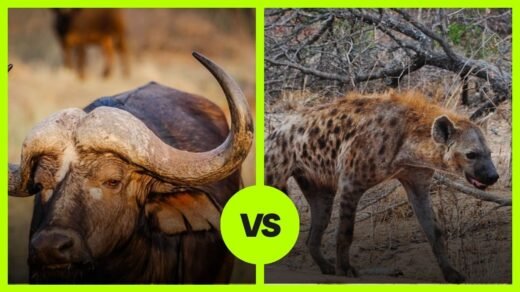When it comes to formidable matchups in the animal kingdom, a showdown between a hippopotamus and a buffalo is the stuff of legends—or nightmares, depending on your point of view. Both of these creatures are natives of the African landscape, each with a reputation for being incredibly tough and aggressive when provoked. While the idea of these two titans clashing is purely hypothetical, analyzing their potential face-off can give us a deeper understanding of their unique characteristics, behaviors, and survival tactics. Let’s delve into the nuances of this imagined battle.
The Contestants
Hippopotamus: The River Behemoth
The hippopotamus, affectionately known as the “hippo,” is a large, mostly aquatic mammal that spends a considerable amount of time in the rivers and lakes of sub-Saharan Africa. Adult male hippos can weigh between 3,300 and 4,000 pounds and can be up to 17 feet long. Although they appear sluggish, hippos are surprisingly agile and can run at speeds up to 25 miles per hour.
African Buffalo: The Grassland Gladiator
The African buffalo is a robust, grazing mammal that can be found in the grasslands, swamps, and forests of Africa. They are formidable in size, with males weighing up to 2,000 pounds and measuring around 11 feet in length. Unlike their domestic counterparts, African buffalos are known for their unpredictable nature and willingness to engage in combat when threatened.
Hippo’s Might and Bite
The hippopotamus’s exceptional strength is a defining characteristic in its combat profile. This strength is a direct result of its massive size and weight, which not only intimidates potential adversaries but also provides a significant physical advantage. The most notable manifestation of this strength is in the hippo’s jaw. Capable of exerting a force of 2,000 pounds per square inch, the hippo’s bite is among the most powerful of any land animal. This crushing force is not just for show; it serves a critical role in the hippo’s ability to defend its territory and combat rivals. A hippo’s bite can easily break the bones of other animals and cause catastrophic damage to any part of an adversary’s body, making it a potent weapon in any combat scenario.
Fighting Skill
Although hippos are not known for a wide range of combat techniques, their effectiveness in using their natural assets is remarkable. Their fighting skill primarily revolves around the strategic use of their massive jaws and powerful body. In a combat scenario, hippos can open their mouths wide and use their jaw strength to bite down on adversaries, aiming to crush or incapacitate them with sheer force. Additionally, their large, heavy bodies are not just for defense. Hippos are capable of using their weight and size as offensive tools, especially in close-quarters combat where they can thrust their bulk onto an opponent, potentially causing injury or disorientation. Their skin, thick and tough, adds an extra layer of defense, making them less susceptible to injuries from counterattacks.
Endurance
The endurance of a hippopotamus in a combat scenario is somewhat nuanced. Despite their significant bulk, which suggests a formidable stamina, hippos are actually more suited to short bursts of intense activity rather than prolonged exertion, especially when out of water. Their large bodies and heavy weight can be a disadvantage in long battles, as they can tire more quickly on land compared to their aquatic environment. In water, their endurance increases significantly, allowing them to sustain longer confrontations. However, on land, in a drawn-out battle, a hippo might find itself at a disadvantage due to its lower stamina over extended periods.
Ability to Finish Opponent
The hippopotamus’s ability to finish off an opponent is a critical aspect of its combat effectiveness. This capability is primarily attributed to its powerful bite, which, when effectively utilized, can be a deciding factor in a fight. A well-placed bite from a hippo can cause fatal wounds, inflicting severe trauma that few animals could withstand or recover from. The sheer force of the bite, combined with the sharpness and size of the hippo’s teeth, allows it to penetrate deeply and inflict significant damage, often resulting in immediate incapacitation or death of the opponent.
Experience with Similar Opponents
In the wild, hippos typically do not engage in combat with animals that match their size and strength. This lack of regular confrontation with similar-sized opponents is primarily because few animals in their natural habitat dare to challenge them, given their reputation and physical prowess. The most common conflicts hippos encounter are intra-species, particularly during disputes over territory or mating rights. These confrontations with other hippos involve displays of dominance, where size, strength, and aggression play crucial roles. Such experiences, while not against diverse adversaries, still hone the hippo’s combat instincts, particularly in terms of asserting dominance and utilizing their natural strengths in confrontations.
Buffalo’s Horns and Endurance
Strength
The African buffalo exhibits a notable strength, particularly in its well-developed neck and shoulder muscles. These muscles are not only a product of its evolutionary adaptation but are also essential for supporting its heavy, horned head. This strength plays a crucial role in the buffalo’s fighting style, which is heavily reliant on the power of its head and neck. When charging, the buffalo can use this strength to generate significant momentum, turning its horns into deadly weapons. This physical power is also vital for withstanding impacts during head-to-head combat, allowing the buffalo to absorb blows from opponents while maintaining its offensive posture. The buffalo’s overall body strength contributes to its ability to push, shove, and knock down adversaries, making it a formidable opponent in any physical confrontation.

Fighting Skill
African buffalos are seasoned fighters, honing their skills through regular encounters with predators and rivals. Their fighting technique revolves around the effective use of their horns, which are not just for defense but are also lethal offensive tools. Buffalos have a natural proficiency in thrusting and goring, often aiming for the most vulnerable parts of an opponent’s body, such as the underbelly or sides. This ability to target weak spots is a testament to their combat intelligence. In addition to their horn-based attacks, buffalos are surprisingly agile for their size. This agility allows them to perform quick maneuvers, aiding them in dodging attacks and swiftly counter-striking. Their agility combined with raw strength makes them unpredictable and dangerous opponents, capable of switching from defense to offense in an instant.
Endurance
Endurance is one of the key strengths of the African buffalo. These animals are accustomed to engaging in prolonged confrontations, particularly with relentless predators like lions. This endurance is not just physical but also mental, as they often face situations where resilience and stamina are crucial for survival. In extended combat scenarios, their ability to maintain high levels of exertion and focus gives them a distinct advantage. This stamina also allows them to recover quickly from exertions, ready to continue fighting or to make strategic retreats when necessary. Such endurance is beneficial in outlasting opponents who may have an initial advantage in strength or speed.
Ability to Finish Opponent
The African buffalo’s primary method of finishing an opponent lies in its skillful use of its horns. These horns, capable of inflicting serious injuries, are used with precision and force in combat. A well-aimed thrust from a buffalo’s horns can be lethal, capable of piercing or crushing an opponent’s body. The buffalo’s finishing ability, while potent, requires more precision and timing compared to the brute force approach of some other large animals. The effectiveness of their horn strikes depends on factors such as angle, speed, and the point of impact, making the buffalo’s ability to finish an opponent somewhat less predictable but still highly dangerous.
Experience with Similar Opponents
African buffalos regularly face off against formidable predators in the wild, which has ingrained in them a deep understanding of high-stakes combat. Predators like lions, while not identical in size to buffalos, are incredibly dangerous and require strategic combat approaches. This frequent exposure to life-or-death situations has honed the buffalo’s combat instincts, teaching them when to engage, when to defend, and when to retreat. Such experiences against serious threats provide them with a practical edge in combat, especially in understanding the dynamics of fighting against agile and powerful adversaries. This experience makes them seasoned and cautious fighters, aware of the risks and strategies involved in engaging with formidable opponents.
Combat Tactics
Hippo’s Aggression
Hippos are notorious for their aggressive behavior, especially when defending their territory or young. They often use their massive jaws to bite down on intruders or rivals, aiming to crush or incapacitate them. Their short, thick legs are also capable of delivering powerful kicks that can inflict serious damage.
Buffalo’s Charge
Buffalos, on the other hand, utilize their impressive horns and bulk in a charge aimed to gore or trample their opponents. They are also more agile than they appear, capable of quick turns and maneuvers that can catch an opponent off guard.
Environmental Considerations
Both animals are well-adapted to the African terrain, but the setting could still play a role in the outcome. For instance, a confrontation near water would undoubtedly give the hippo an advantage, given its adeptness in aquatic environments. On dry land, especially over extended distances, the buffalo’s greater stamina could prove advantageous.

Conclusion: The Heavyweights’ Verdict
Both the hippopotamus and the African buffalo are extraordinary combatants with their own sets of skills and tactics. However, the sheer size, powerful bite, and thick skin of the hippo would give it a distinct advantage in close combat. The buffalo’s horns are indeed lethal, but they would have a hard time penetrating the hippo’s thick hide, while a single bite from the hippo could prove devastating.
Odds of Winning:
- Hippopotamus: 75%
- African Buffalo: 25%
In this hypothetical matchup, the scales tip in favor of the hippopotamus. While the buffalo is formidable and agile, it would likely struggle to overcome the hippo’s sheer size, power, and protective skin. Hence, in this clash of African titans, the river behemoth takes the crown.
Read More about these two:
“Buffalo vs Spotted Hyena: A Battle of Brawn and Teamwork” – This article delves into a fascinating matchup between the formidable African buffalo and the cunning spotted hyena, exploring how teamwork and individual strength play out in the animal kingdom. Read more here.
“Crocodile vs Hippopotamus: The River Rumble” – Dive into an intriguing analysis of a confrontation between two of Africa’s most fearsome river dwellers, the crocodile and the hippopotamus. This piece explores their unique adaptations for survival in aquatic environments. Read more here.
“Giraffe vs Buffalo: The Towering Herbivore Takes on the Horned Tank” – Explore the dynamics of a hypothetical encounter between the tall and majestic giraffe and the robust and horned buffalo. This article examines how size and physical adaptations influence their hypothetical combat tactics. Read more here.




